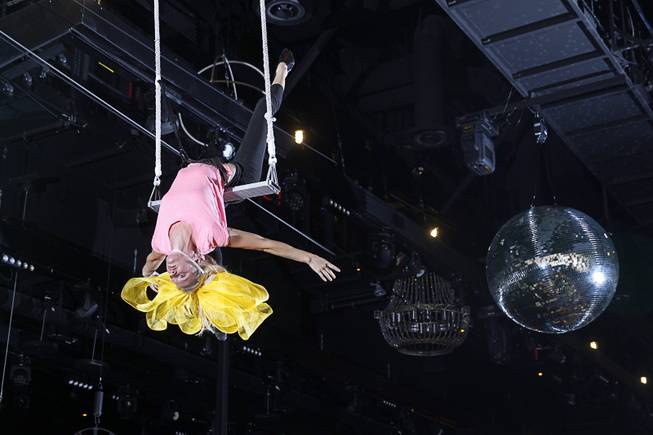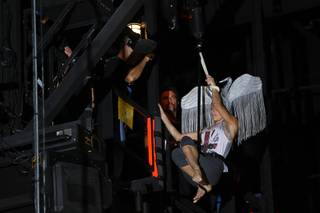
Aerialist Alyssa Gray rehearses in the Life nightclub at the SLS Las Vegas Thursday Sept. 25, 2014.
Sunday, Dec. 14, 2014 | 2 a.m.
You don’t have to shell out big bucks for a stage show to see dazzling theatrical performances in Las Vegas. Just head to a nightclub.
Where go-go dancers and fog machines once stood, stilt walkers and aerialists now reign.
Increasingly, nightclubs are drawing on Las Vegas’ pool of circus artists to awe customers in the Strip’s fiercely competitive race to rule the nightclub market. These days, performers aren’t a novelty; they’re an expectation.
Hakkasan at MGM Grand and Life at SLS have built-in catwalks, rigs and apparatuses, as well as their own branded creative teams of artistic directors and performers. Light at Mandalay Bay, an industry innovator that raised the bar when it opened in 2013, employs a dedicated cast of Cirque du Soleil performers who dangle, dance and roam throughout the club. Recently, the club added clowns to its cast of characters.
Featuring circus artists in nightclubs is far from new. Aerialists were a staple of Las Vegas’ original mega-club, Studio 54, when it opened 17 years ago, and such performers have been used regularly at Las Vegas’ top clubs in the years since. But only recently have the majority begun hiring them.
For the performers, working in a nightclub can be just as challenging, and sometimes more so, than an evening on a traditional stage.
“Every night is different,” said Alyssa Gray, one of five aerialists and about 10 performers who appear at Life three nights a week. “We don’t do anything that’s the same, ever. Whether it’s the costumes or music or performance style, it’s constantly changing and evolving.”
Unlike traditional shows, in which performers might be on stage for 10 minutes at a scheduled time, nightclub performances largely are improvised, with the duration and style dictated by the music and crowd’s energy. In addition to performing, artists may be asked to introduce a DJ, deliver bottle service or interact with the crowd.
Gray typically spends 20 minutes on and 20 minutes off. She gets assigned a new character every night, be it the “Spiny Mermaid” or the bejeweled “Lady in Waiting.” Producers give her three words — “vicious,” “feline,” “cutting,” for example — to describe her character and influence her performance.
“I like the freedom of the nightclub,” Gray said. “You don’t get bored at all. You always get to pull something new out, and there’s a lot of room for personal creativity.”
Nightclub jobs are becoming increasingly common for performers. The growing competition and one-upmanship among local clubs has created more jobs.
“Some people prefer the consistency of a show, but if you can handle late hours, then nightclubs are great,” Gray said. “In entertainment, we’re used to working holidays and nights when everyone else has off.”
Fridays and Saturdays, after performing as a clown in shows like “Le Reve” at Wynn and “The Beatles: Love” at the Mirage, Brett Alters heads to Light, where he dons another clown costume and spends the night warming up the crowd in line and wandering among VIP tables, performing magic tricks and entertaining.
“It’s a really interesting type of medium to work in,” he said. “It’s very similar to street performance, except you’re doing it 40 times per night.”
The work isn’t always glamorous, but Alters says that’s not why he’s in the business. Like Gray, he relishes the opportunity to improvise his own material.
“I’m not above anything as an artist,” he said. “One night, we had a VIP guest whose nickname was Elmo, so I wore an Elmo costume all night. When you’re in a dark, loud nightclub, and your character doesn’t speak but you still have to grab the attention of a table full of people who’ve been drinking, you really have to convince them with your performance. It definitely helps keep your chops up.”
As for pay, the performers say it is comparable to stage shows, while scheduling is more flexible.
Still, as the use of circus artists becomes more common, it’s easier for performers to be taken advantage of, Alters said.
“I have been offered other gigs and have been low-balled,” he said. “Not at higher-level clubs on the Strip ... but elsewhere. These jobs are hard; we shouldn’t be treated like less than what we are. We’re artists. We’re professionals. It’s not about the kind of stage we’re on, it’s about respect.”


Join the Discussion:
Check this out for a full explanation of our conversion to the LiveFyre commenting system and instructions on how to sign up for an account.
Full comments policy